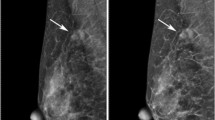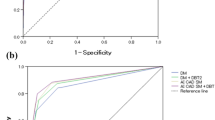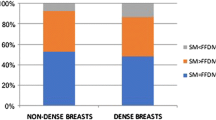Abstract
This study objectively evaluates the similarity between standard full-field digital mammograms and two-dimensional synthesized digital mammograms (2DSM) in a cohort of women undergoing mammography. Under an institutional review board–approved data collection protocol, we retrospectively analyzed 407 women with digital breast tomosynthesis (DBT) and full-field digital mammography (FFDM) examinations performed from September 1, 2014, through February 29, 2016. Both FFDM and 2DSM images were used for the analysis, and 3216 available craniocaudal (CC) and mediolateral oblique (MLO) view mammograms altogether were included in the dataset. We analyzed the mammograms using a fully automated algorithm that computes 152 structural similarity, texture, and mammographic density–based features. We trained and developed two different global mammographic image feature analysis–based breast cancer detection schemes for 2DSM and FFDM images, respectively. The highest structural similarity features were obtained on the coarse Weber Local Descriptor differential excitation texture feature component computed on the CC view images (0.8770) and MLO view images (0.8889). Although the coarse structures are similar, the global mammographic image feature–based cancer detection scheme trained on 2DSM images outperformed the corresponding scheme trained on FFDM images, with area under a receiver operating characteristic curve (AUC) = 0.878 ± 0.034 and 0.756 ± 0.052, respectively. Consequently, further investigation is required to examine whether DBT can replace FFDM as a standalone technique, especially for the development of automated objective-based methods.
Graphical abstract






Similar content being viewed by others
Abbreviations
- DBT:
-
Digital breast tomosynthesis
- FFDM:
-
Full-field digital mammography
- CC:
-
Craniocaudal
- MLO:
-
Mediolateral oblique
- 2D:
-
Two-dimensional
- 2DSM:
-
2D synthesized mammogram
- PD:
-
Percentage density
- SSIM:
-
Structural similarity index metric
- CW-SSIM:
-
Complex wavelet-structural similarity index metric
- CB-SSIM:
-
Correlation-based SSIM
- CB-CW-SSIM:
-
Correlation-based CW-SSIM
- WLD:
-
Weber Local Descriptor
- LDA:
-
Linear discriminant analysis
- ROC:
-
Receiver operating characteristic
- AUC:
-
Area under a ROC curve
- CI:
-
Confidence interval
- FDA:
-
Food and Drug Administration
- PSNR:
-
Peak signal-to-noise
- SIFT:
-
Scale-invariant feature transform
- LBP:
-
Local binary pattern
- RLS:
-
Run-length statistic
- GLCM:
-
Gray level co-occurrence matrix
- LOCO:
-
Leave-one-case-out
References
Al-Kadi OS, Watson D (2008) Texture analysis of aggressive and nonaggressive lung tumor CE CT images. IEEE Trans Biomed Eng 55:1822–1830
Andersson I, Ikeda DM, Zackrisson S, Ruschin M, Svahn T, Timberg P, Tingberg A (2008) Breast tomosynthesis and digital mammography: a comparison of breast cancer visibility and BIRADS classification in a population of cancers with subtle mammographic findings. Eur Radiol 18:2817–2825. https://doi.org/10.1007/s00330-008-1076-9
Aujero MP, Gavenonis SC, Benjamin R, Zhang Z, Holt JS (2017) Clinical performance of synthesized two-dimensional mammography combined with tomosynthesis in a large screening population. Radiology 283:70–76. https://doi.org/10.1148/radiol.2017162674
Byng JW, Boyd NF, Fishell E, Jong RA, Yaffe MJ (1994) The quantitative analysis of mammographic densities. Phys Med Biol 39:1629–1638
Casti P, Mencattini A, Salmeri M, Rangayyan RM (2015) Analysis of structural similarity in mammograms for detection of bilateral asymmetry. IEEE Trans Med Imaging 34:662–671. https://doi.org/10.1109/tmi.2014.2365436
Chang Y-H, Wang X-H, Hardesty LA, Chang TS, Poller WR, Good WF, Gur D (2002) Computerized assessment of tissue composition on digitized mammograms. Acad Radiol 9:899–905
Chen J, Shan S, He C, Zhao G, Pietikainen M, Chen X, Gao W (2010) WLD: a robust local image descriptor. IEEE Trans Pattern Anal Mach Intell 32:1705–1720. https://doi.org/10.1109/tpami.2009.155
Choi G, Woo OH, Shin HS, Jang S, Cho KR, Seo BK (2017) Comparison of two-dimensional synthesized mammogram (2DSM) and conventional full-field digital mammogram (FFDM) for evaluation of breast cancer. Clin Imaging 43:170–174. https://doi.org/10.1016/j.clinimag.2017.03.004
Choi JS, Han BK, Ko EY, Kim GR, Ko ES, Park KW (2019) Comparison of synthetic and digital mammography with digital breast tomosynthesis or alone for the detection and classification of microcalcifications. Eur Radiol 29:319–329. https://doi.org/10.1007/s00330-018-5585-x
Conant EF, Keller BM, Pantalone L, Gastounioti A, McDonald ES, Kontos D (2017) Agreement between breast percentage density estimations from standard-dose versus synthetic digital mammograms: results from a large screening cohort using automated measures. Radiology 283:673–680. https://doi.org/10.1148/radiol.2016161286
D’Orsi CJ, Acr (2014) 2013 ACR BI-RADS atlas: breast imaging reporting and data system. American College of Radiology, Reston
DeLong ER, DeLong DM, Clarke-Pearson DL (1988) Comparing the areas under two or more correlated receiver operating characteristic curves: a nonparametric approach. Biometrics 11:837–845
des Plantes BGZ (1932) EINE NEUE METHODE ZUR DIFFERENZIERUNG IN DER RÖNTGENOGRAPHIE (PLANIGRAPHIE). Acta Radiol 13:182–192. https://doi.org/10.1177/028418513201300211
Galloway M (1975) Texture analysis using gray level run lengths. Comput Graph Image Process 4:172–179
Garayoa J, Chevalier M, Castillo M, Mahillo-Fernandez I, Amallal El Ouahabi N, Estrada C, Tejerina A, Benitez O, Valverde J (2018) Diagnostic value of the stand-alone synthetic image in digital breast tomosynthesis examinations. Eur Radiol 28:565–572. https://doi.org/10.1007/s00330-017-4991-9
Gastounioti A, Conant EF, Kontos D (2016) Beyond breast density: a review on the advancing role of parenchymal texture analysis in breast cancer risk assessment. Breast Cancer Res 18:91. https://doi.org/10.1186/s13058-016-0755-8
Gierach GL, Li H, Loud JT, Greene MH, Chow CK, Lan L, Prindiville SA, Eng-Wong J, Soballe PW, Giambartolomei C, Mai PL, Galbo CE, Nichols K, Calzone KA, Olopade OI, Gail MH, Giger ML (2014) Relationships between computer-extracted mammographic texture pattern features and BRCA1/2 mutation status: a cross-sectional study. Breast Cancer Res 16:424. https://doi.org/10.1186/s13058-014-0424-8
Hadjipanteli A, Kontos M, Constantinidou A (2019) The role of digital breast tomosynthesis in breast cancer screening: a manufacturer- and metrics-specific analysis. Cancer Manag Res 11:9277–9296. https://doi.org/10.2147/CMAR.S210979
Haralick RM, Shanmugam K, Dinstein I (1973) Texture features for image classification. IEEE Trans Syst Man Cybern 3:610–621
Heidari M, Mirniaharikandehei S, Liu W, Hollingsworth AB, Liu H, Zheng B (2019) Development and assessment of a new global mammographic image feature analysis scheme to predict likelihood of malignant cases. IEEE Trans Med Imaging 39:1235–1244. https://doi.org/10.1109/tmi.2019.2946490
Hofvind S, Hovda T, Holen AS, Lee CI, Albertsen J, Bjorndal H, Brandal SHB, Gullien R, Lomo J, Park D, Romundstad L, Suhrke P, Vigeland E, Skaane P (2018) Digital breast tomosynthesis and synthetic 2D mammography versus digital mammography: evaluation in a population-based screening program. Radiology 287:787–794. https://doi.org/10.1148/radiol.2018171361
Hooley RJ, Durand MA, Philpotts LE (2016) Advances in digital breast tomosynthesis. Am J Roentgenol 208:256–266. https://doi.org/10.2214/AJR.16.17127
Kerlikowske K, Grady D, Barclay J, Sickles EA, Ernster V (1996) Effect of age, breast density, and family history on the sensitivity of first screening mammography. JAMA 276:33–38
Marcelja S (1980) Mathematical description of the responses of simple cortical cells. J Opt Soc Am 70:1297–1300
Mariscotti G, Durando M, Houssami N, Fasciano M, Tagliafico A, Bosco D, Casella C, Bogetti C, Bergamasco L, Fonio P, Gandini G (2017) Comparison of synthetic mammography, reconstructed from digital breast tomosynthesis, and digital mammography: evaluation of lesion conspicuity and BI-RADS assessment categories. Breast Cancer Res Treat 166:765–773. https://doi.org/10.1007/s10549-017-4458-3
Nelson JS, Wells JR, Baker JA, Samei E (2016) How does c-view image quality compare with conventional 2D FFDM? Med Phys 43:2538–2547. https://doi.org/10.1118/1.4947293
Portilla J, Simoncelli E (2000) A parametric texture model based on joint statistics of complex wavelet coefficients. Int J Comput Vis 40:49–70. https://doi.org/10.1023/a:1026553619983
Rafferty EA, Park JM, Philpotts LE, Poplack SP, Sumkin JH, Halpern EF, Niklason LT (2013) Assessing radiologist performance using combined digital mammography and breast tomosynthesis compared with digital mammography alone: results of a multicenter, multireader trial. Radiology 266:104–113. https://doi.org/10.1148/radiol.12120674
Rangayyan RM, Ayres FJ (2006) Gabor filters and phase portraits for the detection of architectural distortion in mammograms. Med Biol Eng Comput 44:883–894. https://doi.org/10.1007/s11517-006-0088-3
Rodriguez-Ruiz A, Gubern-Merida A, Imhof-Tas M, Lardenoije S, Wanders AJT, Andersson I, Zackrisson S, Lång K, Dustler M, Karssemeijer N, Mann RM, Sechopoulos I (2018) One-view digital breast tomosynthesis as a stand-alone modality for breast cancer detection: do we need more? Eur Radiol 28:1938–1948. https://doi.org/10.1007/s00330-017-5167-3
Sampat MP, Wang Z, Gupta S, Bovik AC, Markey MK (2009) Complex wavelet structural similarity: a new image similarity index. IEEE Trans Image Process 18:2385–2401. https://doi.org/10.1109/tip.2009.2025923
Skaane P, Bandos AI, Eben EB, Jebsen IN, Krager M, Haakenaasen U, Ekseth U, Izadi M, Hofvind S, Gullien R (2014) Two-view digital breast tomosynthesis screening with synthetically reconstructed projection images: comparison with digital breast tomosynthesis with full-field digital mammographic images. Radiology 271:655–663. https://doi.org/10.1148/radiol.13131391
Soh LK, Tsatsoulis C (1999) Texture analysis of SAR sea ice imagery using gray level co-occurrence matrices. IEEE Trans Geosci Remote Sens 37:780–795. https://doi.org/10.1109/36.752194
Tan M, Aghaei F, Wang Y, Zheng B (2017) Developing a new case based computer-aided detection scheme and an adaptive cueing method to improve performance in detecting mammographic lesions. Phys Med Biol 62:358–376
Tan M, Mariapun S, Yip CH, Ng KH, Teo S-H (2019) A novel method of determining breast cancer risk using parenchymal textural analysis of mammography images on an Asian cohort. Phys Med Biol 64:035016. https://doi.org/10.1088/1361-6560/aafabd
Tan M, Pu J, Cheng S, Liu H, Zheng B (2015) Assessment of a four-view mammographic image feature based fusion model to predict near-term breast cancer risk. Ann Biomed Eng 43:2416–2428. https://doi.org/10.1007/s10439-015-1316-5
Tan M, Qian W, Pu J, Liu H, Zheng B (2015) A new approach to develop computer-aided detection schemes of digital mammograms. Phys Med Biol 60:4413–4427. https://doi.org/10.1088/0031-9155/60/11/4413
Tan M, Zheng B, Leader JK, Gur D (2016) Association between changes in mammographic image features and risk for near-term breast cancer development. IEEE Trans Med Imaging 35:1719–1728
Tan M, Zheng B, Ramalingam P, Gur D (2013) Prediction of near-term breast cancer risk based on bilateral mammographic feature asymmetry. Acad Radiol 20:1542–1550. https://doi.org/10.1016/j.acra.2013.08.020
Wang Z, Bovik AC, Sheikh HR, Simoncelli EP (2004) Image quality assessment: from error visibility to structural similarity. IEEE Trans Image Process 13:600–612
Zuckerman SP, Conant EF, Keller BM, Maidment AD, Barufaldi B, Weinstein SP, Synnestvedt M, McDonald ES (2016) Implementation of synthesized two-dimensional mammography in a population-based digital breast tomosynthesis screening program. Radiology 281:730–736. https://doi.org/10.1148/radiol.2016160366
Zuley ML, Guo B, Catullo VJ, Chough DM, Kelly AE, Lu AH, Rathfon GY, Spangler ML, Sumkin JH, Wallace LP, Bandos AI (2014) Comparison of two-dimensional synthesized mammograms versus original digital mammograms alone and in combination with tomosynthesis images. Radiology 271:664–671. https://doi.org/10.1148/radiol.13131530
Acknowledgments
The authors acknowledge Dr. Nazimah Ab Mumin from University Teknologi Mara for contributing most of the images used in this study.
Funding
This study was funded by the Electrical and Computer Systems Engineering and Advanced Engineering Platform, School of Engineering, Monash University Malaysia, and the University of Malaya Research Grant (Grant Number: PO035-2015).
Author information
Authors and Affiliations
Corresponding author
Ethics declarations
Conflict of interest
The authors declare that they have no conflict of interest.
Ethical approval
All procedures performed in studies involving human participants were in accordance with the ethical standards of the institutional and/or national research committee and with the 1964 Helsinki declaration and its later amendments or comparable ethical standards.
Informed consent
Informed consent was waived by the obtained IRB approval.
Additional information
Publisher’s note
Springer Nature remains neutral with regard to jurisdictional claims in published maps and institutional affiliations.
Rights and permissions
About this article
Cite this article
Tan, M., Al-Shabi, M., Chan, W.Y. et al. Comparison of two-dimensional synthesized mammograms versus original digital mammograms: a quantitative assessment. Med Biol Eng Comput 59, 355–367 (2021). https://doi.org/10.1007/s11517-021-02313-1
Received:
Accepted:
Published:
Issue Date:
DOI: https://doi.org/10.1007/s11517-021-02313-1




